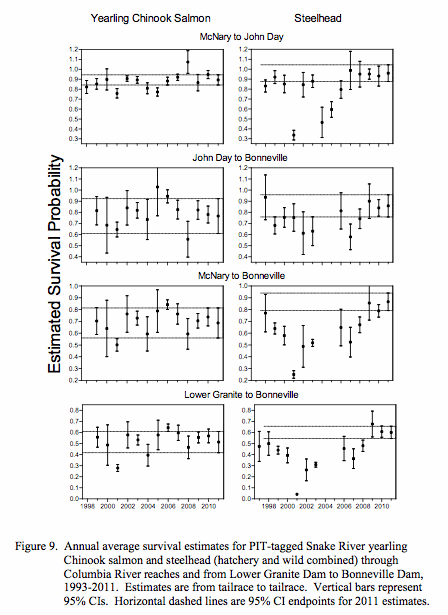forum
library
tutorial
contact

Juvenile Spring Outmigration on Columbia,
Snake Unusually Low in 2015
by Laura Berg
Northwest Fishletter, November 2, 2015
|
the film forum library tutorial contact |

|
Juvenile Spring Outmigration on Columbia,
by Laura Berg
|
For Snake River hatchery and wild sockeye in 2015, survival from the tailrace of Lower Granite Dam to
the tailrace of Bonneville Dam was 37.3 percent. Since 1998, five other years have had lower survival rates.
 A preliminary report on juvenile fish passage at Columbia and Snake river dams concluded that 2015 survival rates were generally well below average. The lower survival estimates "were associated with a set of extreme environmental conditions and unusual operational conditions compared to past years," said the analysis produced by NOAA Fisheries' Northwest Science Center in Seattle.
A preliminary report on juvenile fish passage at Columbia and Snake river dams concluded that 2015 survival rates were generally well below average. The lower survival estimates "were associated with a set of extreme environmental conditions and unusual operational conditions compared to past years," said the analysis produced by NOAA Fisheries' Northwest Science Center in Seattle.
On the Snake River, flows during the April 1-June 15 spring migration period were low, with a mean of 53 kcfs as observed at Little Goose Dam. The only year with lower flows in 1998-2015 was 2001, with a mean of 48.9 kcfs.
Mean water temperature, on the other hand, was 55.8 degrees during the migration period, the highest measured at Little Goose in 1998-2015. There were no comparable years, the preliminary report added.
Mean spill discharge at Snake River dams during the 2015 migration was 19.9 kcfs, below the long-term (1998-2015) mean of 25.7 kcfs. But spill as a percentage of flow at Snake River dams was above the long-term mean. In 2015, the percentage was 37.7, while the long-term percentage was 25.9, the highest in the 1998-2015 period.
The number of young salmon and steelhead transported was low during the 2015 spring migration period. Many of the juveniles arrived before transportation start dates.
These constraints resulted in one of the poorest years for juvenile fish survival in the past 17 years. Survival estimates for juvenile salmon and steelhead migrating through the hydro system are based on PIT-tag detections going back to the 1990s, in work funded by BPA. For Snake River hatchery and wild Chinook, the 2015 estimated juvenile survival from the Snake River trap to Bonneville Dam tailrace was 39.7 percent, the third lowest since 1998. For the run's wild component, survival was estimated at 38.4 percent.
For Snake River hatchery and wild steelhead, the 2015 survival rate from the Snake River trap to Bonneville Dam trailrace was 36.1 percent, the fourth lowest since 1997. For wild steelhead, the 2015 survival rate from the Snake River trap to Bonneville Dam tailrace was 30.1 percent.
For Snake River hatchery and wild sockeye in 2015, survival from the tailrace of Lower Granite Dam to the tailrace of Bonneville Dam was 37.3 percent. Since 1998, five other years have had lower survival rates.
For upper Columbia River hatchery and wild sockeye, 2015 survival from the tailrace of Rock Island Dam to the tailrace of Bonneville Dam was 34 percent. Only three years since 1998 have been lower.
For hatchery Chinook originating in the upper Columbia River, 2015 survival from McNary Dam tailrace to Bonneville Dam tailrace was 87 percent, about average for the years between 1999-2015.
For hatchery steelhead originating from the upper Columbia River, the 2015 survival from McNary Dam tailrace to Bonneville Dam tailrace was 57 percent, the lowest since 2002. (No data is available before 2002.)
A final report, due in early 2016, could adjust the survival rates estimated in this preliminary analysis by 3 to 4 percent.
A mitigating factor during this year's juvenile outmigration was travel time for Snake River Chinook and steelhead between Lower Granite and Bonneville dams. It was shorter than in most low-flow years since 2001, although longer than in some recent years.
A reason for different travel times under the 2015 conditions and those in low-flow years such as 2001 and 2004 is that those earlier years had no spill for extended periods of time. Also, most dams had limited surface bypass structures or none at all, the survival report said.
"Even small amounts of spill, especially surface spill, during low-flow conditions can be attractive to fish looking for passage through a dam," the analysis said.
"When spill is shut off completely, fish delay passage because the only available routes are through powerhouse intake bays, which have horizontal entrance depths of 20 meters or more below the surface.
"This is in contrast to entrances to normal spillways which lie approximately 10 meters below the surface and spillway weirs which entrain the top 1-2 meters of surface flow," the report noted. "Migrating smolts are naturally surface oriented, so depth can be a behavioral barrier to passage."
In other words, without spill and surface bypass structures, juvenile fish survival could have been worse.
learn more on topics covered in the film
see the video
read the script
learn the songs
discussion forum
